
History of Choy Lee Fut 蔡李佛的歴史


Jeung Yim 張炎 (1824-1893) was born in Sek Hoi Village 石咀村 in Sun Wui County 新會縣, Gwong Dung Province 廣東省. In his youth he had a passion for learning the martial arts and began learning kung fu from a Shaolin Monk named Lee Yau San 李友山, master of the southern Lee Ga 李家 (Lee Family Style). While still at a young age his parents were killed, which left him under the care of his uncle Jeung Gwan 張昆. His uncle though had to leave town on business and wouldn't be able to take his young nephew with him. So, he decided to pay a visit to his old friend Chan Heung who was a former student of Jeung’s teacher Lee Yau San. Chan lived in a nearby village called Ging Mui 京梅鄉 where he had become a kung fu instructor.
Chan Heung 陳享 (1815-1875) was born in Ging Mui Village 京梅鄉 of Sun Wui County 新會縣. He began learning kung fu from his uncle Chan Yuen Wu 陳遠護, a common disciple of Shaolin. He trained hard and became quite skilled under his uncles teaching. One day Chan had heard of another master who had come to the village to teach, this was Lee Yau San 李友山. He took up training under the new master and excelled in his studies. Lee had told Chan much about Shaolin and its history, also mentioning about the 5 elders (5 Ancestors of Southern Shaolin 南拳五祖) who had escaped the destruction of the Shaolin Temple. Chan was interested in this story and found that one of the elders, Choy Fuk 蔡褔, was living on a nearby mountain named Loh Fu Mountain 羅浮山. With his teachers permission Chan set off to seek out this master. He eventually found the monk and was accepted for training. He followed Choy Fook, a master of Choy Ga 蔡家 (Choy Family Style) for many years learning the Shaolin arts, and with his talent was able to learn the genuine essence of kung fu. After several years of training under Choy Fook, Chan Heung left and was recruited working as a drillmaster in Chan Village 陳村, in San Dak County 順德縣, of Gong Mun City 江門市, where he taught the villagers to defend themselves. He took what he had learned and formed a new system. He then opened up a school and began teaching.
When Jeung Yim met Chan Heung through his uncle’s introduction he expressed his desire to learn kung fu. Though he was still young Jeung had received prior training under Lee Yau San, Chan’s former teacher. Though Chan Heung could see Jeung’s desire and happy to meet a fellow classmate there was a problem. In the Chan Village 陳村 there was a rule that a drillmaster should not accept an outsider (non-Chan) for training to learn their village’s kung fu. Chan Heung was bound to this rule, but decided however to take Jeung Yim as chore man in his exercising hall, cleaning and straightening up. Jeung Yim was then only twelve but was determined to learn. Day by day as classes were being conducted he continued working nearby and watching. Jeung remembered every step while the disciples were exercising, and then later would train in private. Day after day he watched and remembered, all while maintaining his silence. This carried on for some time until one day Chan discovered Jeung training his stolen kung fu. He was upset at first to see this however upon approaching him about this Jeung Yim was honest about his deception and asked for forgiveness. Chan then asked what he had learned and Jeung Yim showed what he had been practicing. The performance and Jeung Yim’s ambition moved Chan Heung, convincing him to train and guide the young boy, providing he would tell no-one. He trained Jeung during the night when no one was around, and Jeung maintained his silence during class, often enduring the bullying that came from the students. Five years had passed and Jeung Yim had mastered his lessons from Chan, unknown to anyone else.
One day, Chan Heung went out to deal with something and left the disciples training in the hall. They saw Jeung working on his daily chores nearby and wanted to put him to the shame as he was an outsider. They tried to force him to fight but Jeung maintained. They treated him as a coward and insulted him to the point where Jeung could no longer endure. He finally fought back. To their surprise he defeated the students and many got wounded in the process. The secret was out and when Chan Heung returned he was accused of teaching the village kung fu to an outsider.
The villagers were upset at this break of tradition leaving Chan no choice but to expel Jeung to maintain peace in the village. However, during his training with the monk Choy Fook, he had learned of another master of even higher skill. Chan hadn’t the chance to seek out this master but decided to pass the chance onto Jeung. He arranged Jeung Yim with a letter of introduction to go to Jaap Gin Temple 閘建寺 on Baat Paai Mountain 八排山 in Gwong Sai 廣西 for training under Ching Cho Woe Serng 青草和尙 (a.k.a. Fong, Dai Hung 方大洪), the “Green Grass Monk 青草僧”. Ching Cho was a senior teacher and survivor of the destroyed Shaolin Temple. He had built a new temple at the 9 Lotus Mountain 九蓮山少林寺 under the Abbot Ji Sim 至善禪師, and now lived in solitude in the mountains.
Jeung Yim departed and found Ching Cho at the temple as instructed. He was accepted as a student and for the next 8 years (1841-1849) Jeung Yim learned the deadly Shaolin art of Fut Mun Jeung 佛門掌 (Buddhist Palm). This was actually not a formal style of its own, but rather a generic name for the skills and techniques that came from Shaolin. He completely imparted the Buddhism Palm techniques and methods to Jeung Yim, and also taught medical knowledge and to accept the idea of revolting Ching and recovering Ming 反清復明. Time passed quickly and Jeung Yim completed his training. Ching Cho who belonged to the Hung Mun Society 洪門 was himself a revolutionary. He renamed him Hung Sing 鴻勝 (鴻 Hung instead of 洪 Hung to disguise the meaning, though both having the same pronunciation in Chinese) meaning “victory to the Hung”, telling him to leave the temple and contact patriots and comrades to fight for Ming’s recovery.
Jeung Hung Sing left to join the Tai Ping Rebellion 太平天國革命 to spend the rest of his life in battle and training revolutionaries to fight, but first returned to Ging Mui where Chan Heung warmly welcomed him. In their meetings, Jeung Hung Sing shared what he learned from the Green Grass Monk with Chan Heung in appreciation for his tutelage years before. During this exchange a new method was born. The 2 masters parted ways and separately developed their respective systems. Since their kung fu was from 3 sources; Choy Fook’s Choy Ga, Lee Yau San’s Lee Ga, and Ching Cho’s Fut Ga Jeung, they named the style Choy Lee Fut in honor of the styles source. Jeung Hung Sing taught under the name of Hung Sing Kwoon 鴻勝舘 and Chan Heung taught under the name of Hung Sing Kwoon 洪聖舘. Though sharing the same roots these 2 branches of Choy Lee Fut evolved separately and took on their own respective characteristics and attributes.
Emperor Huang-Ti (Huang Di) 2497-2398BC
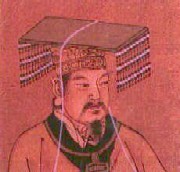
Huang-Ti
黃帝 Emperor "Huang-Ti" (Huang Di)

Replica compass
Emperor Huang-Ti (Huang Di) China's "Yellow Emperor" is credited for devising the first martial arts dating as far back as 2450BC. Emperor Huang-Ti taught a group of military soldiers a form of martial arts to fight against Emperior Chi You at the Battle of Zhuolu. Emperor Huang-Ti was victorious in the battle.
A legend about Huang-Ti's wife Lúo Zǔ is that she taught the Chinese how to weave the silk from silkworms, and his historian Cāng Jié created the first Chinese characters.
Other legends also say that the Yellow Emperor invented a magical compass during a battle against Chi You who used a great fog to obscure his enemy's sight. Thanks to the compass, the Yellow Emperor found out where Chi You was and defeated him. The compass was actually a chariot with a pointer which always pointed south. Among Huang-Ti's many accomplishments, the Yellow Emperor has been credited with the invention of the principles of TCM (Traditional Chinese Medicine) 中醫.
General Kwan Ti (Guan Di) ? - 220AD
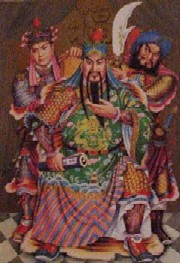
Kwan Ti with God Brother &
Body Guard
Body Guard
關帝 General "Kwan-Ti" (Translated, "Emperor Kwan")
China's most famous General Kwan Ti! General Kwan Ti or sometimes romanized as "Guān Yǔ, Kuan Yu (關羽) (common name) or Kuan Kung, Guān Gōng (關公) translates as Lord Guan" are some of the more popular names however, the list of names is rather long to list them all. General Kwan Ti is known as the "God or Saint of War"
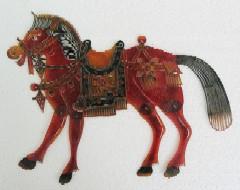
Kwan Ti's horse named "Red Hare"
General Kwan Ti's picture can be found in just about any restaurant, police station, kung fu school and public building throughout Hong Kong, China, Taiwan and Singapore. It should also, be noted that a small shrine of Kwan Ti can be found throughout the rest of the world in almost any Chinese restaurant or kung fu school.
General Kwan Ti was famous for many things one of which was the weapon named after him the "Kwan Dao" (Guan Dao) 關刀 "Dao" 刀 meaning sword. General Kwan Ti's Kwan Dao weighed an estimated 82 Chinese jin (49 kg) or (108 lb).
Legend has it that both General Kwan Ti and his horse "Red Hare" 赤兔馬 rode for three days and three nights without food and water to save a princess.
One can read about it in the novel titled "Romance of Three Kingdoms" by Luo Guanzhong and translated in English by Moss Roberts and another older version by C.H. Brewitt-Taylor. Visit www.China-On-Site.com to view a copy of "ROTK" and also find out how to purchase a copy of Romance of Three Kingdoms by Luo Guanzhong.
~Quotes from Romance of Three Kingdoms~
"I'd rather betray the world than let the world betray me". -Cao Cao
"The world can do without Cao Hong, but not without you, my lord"! -Cao Hong
"The northern people are riders and the southern people sailors; it is said quite true". -Liu Bei
"The world can do without Cao Hong, but not without you, my lord"! -Cao Hong
"The northern people are riders and the southern people sailors; it is said quite true". -Liu Bei
Bodhidharma "Da-Mo" (Ta-Mo) 527AD
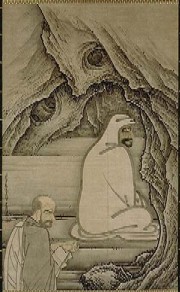
Bodhidharma
菩提達摩 Bodhidharma The spread of Chán禪 (Zen Buddhism)
Bodhidharma 菩提達摩 an Indian Monk born in south India is known for the spread of Chán禪 (Zen Buddhism) to China. The Shaolin Monastery "Chigong" (Qigong) manual called "Ichinching" (Yijinjing) 易筋經 translation (muscle/tendon change classic) credits Shaolin Kung Fu to Bodhidharma, which makes Bodhidharma an important influence on the martial arts throughout Asia.
Bodhidharma has many legends and this legend is one of the more popular ones. The legend says that Bodhidharma first traveled to Southern China once there he failed to make a favorable impression. Bodhidharma then traveled to the Northern Chinese kingdom of Wei (527 estimated) to a cave near the Northern Shaolin Monastery in Henan province, where he "faced a wall for nine years, not speaking for the entire time".
This story is told in three other Chinese versions.
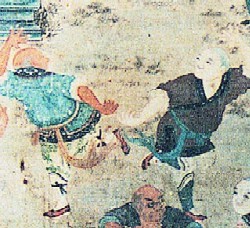
Shaolin monks
In one version of the story, he is said to have fallen asleep for seven years into his nine years of wall-gazing. Becoming angry with himself, he cut off his eyelids to prevent it from happening again. According to the legend, as his eyelids hit the floor the first tea plants sprang up, and thereafter tea would provide a stimulant to help keep students of Chán禪 awake during meditation.
In another version of the story, after the nine years, Bodhidharma "passed away, seated upright".
In another, Bodhidharma disappeared, leaving behind the "Ichinching".
In the Japanese version of the legend, Bodhidharma's legs atrophied after nine years of sitting, which is why Japanese Bodhidharma dolls (Daruma doll) have no legs.
Another legend describes Bodhidharma arriving at Shaolin Monastery (527 estimated) and seeing the monks in a very poor and week physical condition. As the monks spent their days transcribing scrolls and not getting enough physical exercise. It was then that Bodhidharma, created some breathing and stretching exercises and some of which were in the form of meditation. The Shaolin monks called Bodhidharma "Da-Mo" (Ta-Mo). However, it should be noted that there are many legends and stories about Bodhidharma and the way he lived his life.
Frequently Asked Questions
What is kung fu 功夫?
Kung fu (or in Cantonese pronounced Gung Fu / Mandarin pronounced Gōng Fu, the "K" is a western adaptation) is a word used to describe the Chinese martial arts. The word in Chinese for martial arts is wu-shu 武術. The word kung fu means "hard worker" or sometimes working hard depending on how it is used. It became popular in the early "70's".
The word kung fu originally was used to describe how the practitioners were seen. Origins of when the word kung fu was first used to describe martial arts is unknown. There are many stories of how someone said, hey look at those "hard workers" over there and it stuck. Today the word "kung fu" is famous around the world for Chinese martial arts!
There are many aspects of kung fu such as mind and body strengthening, self-defense, empty hand forms, weapon forms, philosophy and herbal medicines.
The word kung fu originally was used to describe how the practitioners were seen. Origins of when the word kung fu was first used to describe martial arts is unknown. There are many stories of how someone said, hey look at those "hard workers" over there and it stuck. Today the word "kung fu" is famous around the world for Chinese martial arts!
There are many aspects of kung fu such as mind and body strengthening, self-defense, empty hand forms, weapon forms, philosophy and herbal medicines.
What kind of curriculum's will a student follow?
All students will be trained through a vigorous basic program that consists of exercises and drills along with beginner hand forms. With in weeks a student will feel a definite improvement in their over all well-being and flexibility.
Students will be taught at a rate of what they are capable of doing. This way the student can achieve a higher standard of kung fu and in little to no time a student is learning advanced forms.
Students will be taught at a rate of what they are capable of doing. This way the student can achieve a higher standard of kung fu and in little to no time a student is learning advanced forms.
What about ranking and belts?
Traditionally kung fu practitioners in China don't use a belt system they, wear a sash. The belt ranking system came about when judo became a sport in Japan and then later all other Japanese and Korean martial arts soon adopted the same type of system for ranking. This is traditional kung fu and therefore, students in class wear a black sash.
However, it should be noted that a sash supports the lower back and lower abdomen.
However, it should be noted that a sash supports the lower back and lower abdomen.
What does "Sifu" 師父 mean?
Sifu or sometimes spelled "Sefu" and "Shifu" means Master. The Chinese character here 師 (Si) translates as Teacher and the Chinese character here 父 (Fu) translates as father.
Kobe Chinese Martial Arts Association is a family environment
Being a family is all about helping each other out.
Being a family is all about helping each other out.
"Club Creed"
Provided by Hung-Sing Guan San Francisco, CA USA
- I will honor and obey my Sifu.
- I will train hard.
- I will respect my fellow classmates.
- I will eat healthy.
- I will not bring dishonor or negative attention to my school and my Sifu.
- I will not misuse drugs or alcohol.
- I will not bully anyone weaker than myself or misuse my gung fu in any way.
- I will obey all laws of the land.
- I will protect those that cannot defend themselves.
- My main purpose of learning martial arts is to build a strong body, mind, and spirit, as well as to be able to protect myself from harm.
"The 10 Rules of Good Conduct"
Provided by Hung-Sing Guan Fut-San, China
- Seek approval of your Sifu for all things relative to the school, style, and branch.
- Develop strength thru endurance.
- Practice hard daily.
- Practice your "Chi-Gong" "breathing techniques" daily.
- Always do your best.
- Make sounds "Yik for punches", "Wah for tiger claws" and "Tik for kicks".
- Sex in moderation (modified from Buddhist philosophy that says avoid altogether).
- Stand up for yourself. Never back down, "unless it's to your advantage".
- Always eat a healthy diet.
- Through practice, never allow yourself to be bullied. Always remain self-confident.


